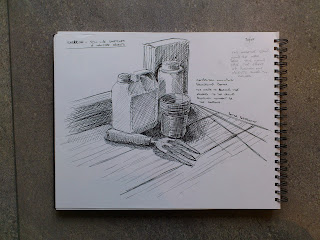Exercise - Observing shadow and light formations on a surface
When objects are pale coloured and on a pale surface, it is relatively easy to distinguish both shadow and direct and reflected light on surfaces. It becomes more difficult when the objects are different colours or textures. This exercise did show how much effect reflected light from a surface has to the underside of an object.
 |
| Tonal studies showing primary light source, shadows and reflected light |
Exercise - Tonal Studies
I found with this exercise that it's difficult to match tonal grades between different mediums. For example the lightest marks made with a dip pen are still much darker than the equivalent marks made with an HB pencil.
 |
| I was pleased with how the tones defined the forms of these objects and how the lighter areas lift the object from the background. |
Research Point - Odilon Redon
Odilon
Redon was born in Bordeaux, France and showed artistic ability whilst still at school, having lessons in drawing and watercolour. At the age of 15 he began to formally study drawing but his father insisted on him studying architecture however he failed to qualify for entry to the Paris’ École des Beaux-Arts, putting an end to those career plans. He took part in the Franco-Prussian War in 1870 and moved to Paris after that. It could be said that his experiences at that time combined with the death of his father and son in 1886, contributed to his works of this period which he called his 'Noirs'. These works in dark charcoal have a nightmarish quality that may have reflected his state of mind. Below are links to two of these works that appear to be typical of this period:
Guardian spirit of the waters
The crying spider
Guardian spirit of the waters
The crying spider
Redons work was not widely known until in 1884 a J K Huysman’s novel “A Rebours” (“Against Nature”) was published
in which one of the characters collected drawings by Redon. This wider recognition also cemented his association with Symbolism, a literary movement focusing on the imagination as its creative inspiration. The Symbolist painters rejected the Realism and Impressionism art of the time as being too limiting, whilst using stylised images that created dream like scenes.
Odilon kept a journal which might give some insight into his work. He
explains that painting the smallest details of an object before him left him totally dissatisfied. However approaching the subject from his imagination and then he would feel the assurance and release. Redon's work seems to be an exploration of the workings of his mind at any given period in his life.






















